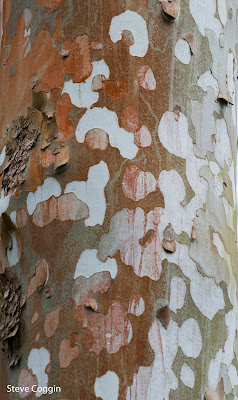 |
| Male Yellow-bellied Sapsucker (Sphyrapicus varius). Rowan County, North Carolina. |
In the
spring, as the days lengthen and temperatures warm, birders eagerly await the
return of the neotropical migrants.
These birds spent the winter in warmer climes and they appear in waves,
wearing their brightest colors and singing their brightest songs. But winter brings its own special birds. As the migrants wing their way south a whole
suite of avian guests come from the north and spend the winter in
Southeast.
 |
| Sapsucker holes in the trunk of Red Tip Photinia (Photinia x fraseri). Rowan County, North Carolina. |
 |
| Male Yellow-bellied Sapsucker feeding on suet in mid-winter. Rowan County, North Carolina. |
One of our
winter visitors is the Yellow-bellied Sapsucker (Sphyrapicus varius). This
medium-sized woodpecker has black and white stripes on the face, a bold white
patch on the wing and some individuals show yellow on the belly. Both male and female Yellow-bellied
Sapsuckers have a red on the top of the head but the males also have a bright
red throat. These birds breed across a
wide swath of Canada and the Northern United States east of the Rocky
Mountains. They winter in the South
Central and Southeastern US, the Caribbean and Central America. Their name sapsucker comes from their habit
of drilling rows of small holes with their chisel beak in tree trunks. The Yellow-bellied Sapsucker does drink some
of the sap that flows from these holes but also consume insects that
come to feed on the sap.
 |
| Hermit Thrush (Catharus guttatus) showing off its reddish-brown tail. Rowan County, North Carolina. |
 |
| Hermit Thrush. Rowan County, North Carolina. |
The Hermit
Thrush (Catharus guttatus) is another
bird that spends the winter in our area.
These birds are a little smaller than their relative the American Robin
(Turdus migratorius). Hermit Thrushes have spots on the throat, a
brown back and a reddish brown tail. They also have a habit of drooping their wings when perched. Hermit Thrushes live in the forest understory and constantly bob their tail. They breed from Alaska to the Canadian
Maritimes and down the Rocky Mountains.
Hermit Thrushes spend the winter along the West Coast, the lower third of the
United States and Mexico. Their
preferred food is berries but will also take insects, particularly in the
breeding season. Hermit Thrushes, like other members of the thrush family, have
a flute-like song but we rarely get to hear it in winter.
 |
| Hermit Thrushes often droop their wings when perched. Horry County, South Carolina. |
Purple
Finches (Haemorhous purpureus) breed,
like the other winter visitors, in Canada and the Northern United States. Males and females of this species look very different from each other. The males have purple wash over their head,
neck, and back. Their breast white with
pink stripes. The great naturalist and
field guide author, Roger Torrey Peterson, described the male Purple Finch as “Like a sparrow
dipped in raspberry juice”. Females have
the same pattern as the males but are brown where the male is purple. Female Purple Finches are easy to tell from the similar female House Finches (Haemorhorus mexicanus) because they have a white line over their eyes that the House Finches lack. Purple Finches are mainly seedeaters and have a large, seed crunching beak. Some winters these finches are rare but when
the seed crop in Canada is sparse, large numbers move south. Purple Finches will visit bird feeders where
they prefer sunflower and thistle.
 |
| Female Purple Finch (Haemorhous purpureus). Rowan County, North Carolina. |
 |
| Female and male Purple Finches. Rowan County, North Carolina. |
Another
northern seedeater is the Pine Siskin (Spinus
pinus). These birds are also
sporadic visitors to the Southeast and often show up with Purple Finches. Pine Siskins are smaller than Purple Finches
with a finer, pointed beak. They have flashes
of yellow on the wing and tail and a streaked breast. Pine Siskins are even more voracious at the
feeders than Purple Finches. Some people
who feed birds hate to see these flying pigs appear because they love thistle
and that seed is expensive.
 |
| Five Pine Siskins and one American Goldfinch (Spinus tristus) on a thistle feeder. Rowan County, North Carolina. |
 |
| Three Pine Siskins and a female Purple Finch eating sunflower and suet. The Pine Siskins have yellow on their wings and tails. Rowan County, North Carolina. |
This year
the Eastern Canada conifer seed crop was poor so Pine Siskins and Purples
Finches are streaming into the south in what is called an irruption. Even rarer
northern birds may join them to spice up the winter months. Keep an eye out for these and other winter
birds.













































